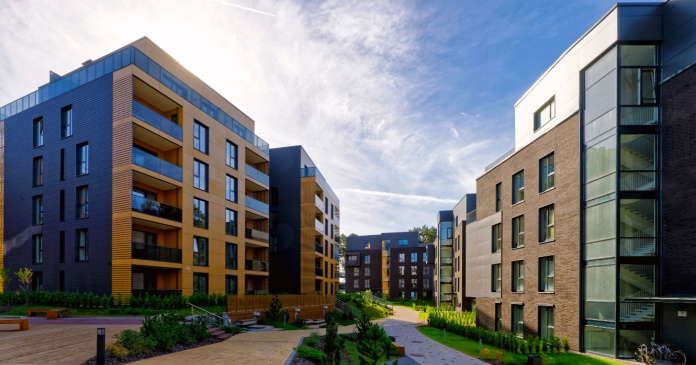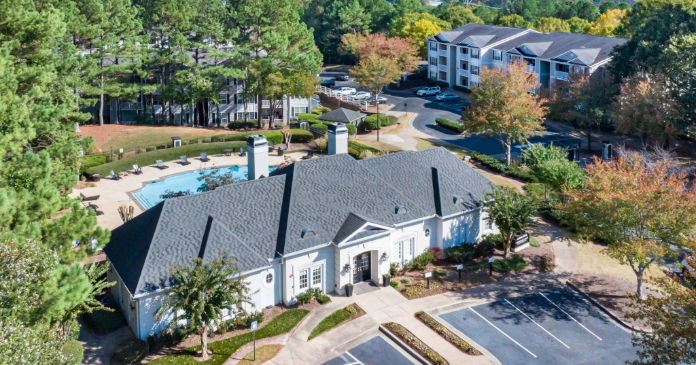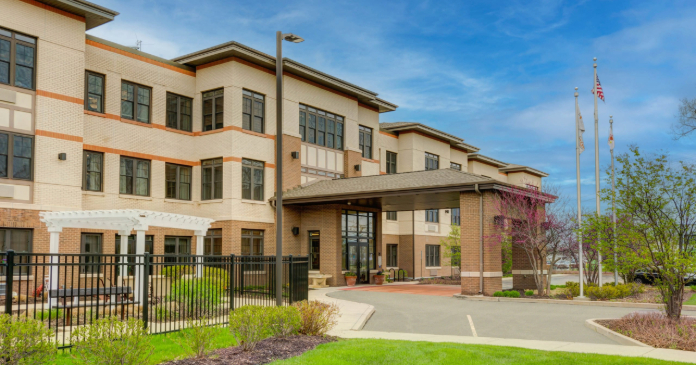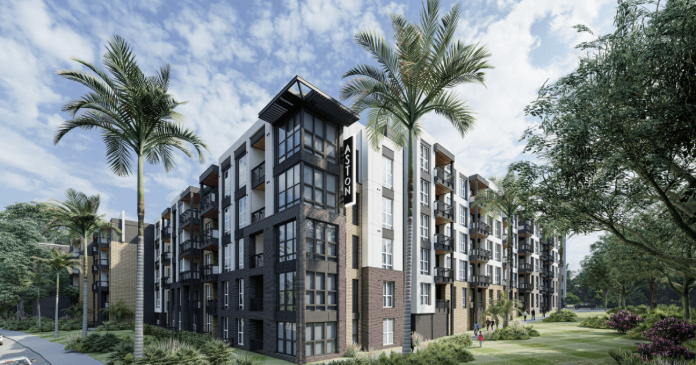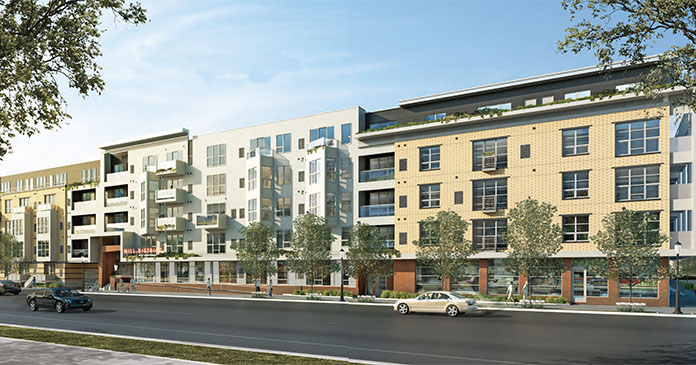
He would rather operate his apartment business in the Midwest markets, where there is a controlled amount of supply and flat to small population and employment growth, than in over-supplied markets with more robust population and job growth.
But the Midwest’s largest developer, owner and manager of apartments also manages apartments for third-party clients in 13 states and 25 cities.
“We operate about 40,000 units and have ownership interest in a little less than a third of those. But from an ownership standpoint, we like the Midwest,” said Holtzman.
Village Green’s regional focus has paid off with the delivery of an apartment project that received unlikely funding during the credit freeze of the Great Recession.
On January 25, Village Green held its grand opening for the 175-unit Mill District City Apartments, a brand new luxury rental community in Minneapolis’ Mill District, capitalizing on the shifting preferences of an upscale demographic that a few years earlier would have been buying newly built condos or lofts in renovated old mill structures in that trendy historic neighborhood.
The Mill District, part of Minneapolis’ larger Downtown East neighborhood, sits on the bank of the Mississippi, just above the river’s only waterfall, St. Anthony Falls, and in close proximity to downtown and a burgeoning arts and entertainment center with a growing number of restaurants and shops. Village Green’s development brings to the area the first new luxury multifamily (and the only luxury rentals units) since hundreds of condos sprouted in the condo boom of the past decade.
Village Green started the $30 million Mill District City Apartments in October 2009, during the Great Recession’s deepest financing freeze, on the site of a condo development that never got off the ground and one of the last remaining undeveloped parcels in the area. Apartment vacancy that year in the Twin Cities area peaked at 7.3 percent.
The project has served as an icebreaker in the standoff between Minneapolis lenders who had frozen their loan pipelines and developers unable to move forward on stalled projects without the necessary construction financing.
Today, 597 multifamily units are in various stages of development in Minneapolis, including the 216-unit Flux apartments by Greco Development, located on the city’s Midtown Greenway, and a couple of smaller developments that will begin delivering in the latter part of this year.
Holtzman credits his project’s success to Village Green’s maverick business philosophy. “We are contrarian, always have been. You build in a recession and you deliver units as the economy is improving. Traditionally, it has always been the best way in any form of real estate,” said the thirdgeneration owner of the company that was launched as a homebuilder by his grandfather Joseph Holtzman in 1919, and switched to a multifamily focus in the 1960s.
That Mill District City Apartments got off the ground when it did is a testament to Village Green’s track record, established relationships and Holtzman’s belief in the benefit of being intimately acquainted with your own backyard.
“I always felt that knowing your backyard is highly respected by your clients, lenders, partner associates and renters. It’s a positive and everyone we work with thinks it’s a positive,” said Holtzman.
“Village Green had built four brand new apartment projects in Downtown Minneapolis and had an excellent relationship with the neighborhoods, the mayor, the aldermen and the people in the city and we enjoyed doing business in Minneapolis. So we received a phone call and we were actively looking for a site to do another deal,” said Holtzman.
But putting the project together wasn’t easy. The site was jointly owned by the city of Minneapolis and Brighton Development Company, which originally planned to build condos and a live/work project, but cancelled those plans in 2007 as the condo market started to fall apart.
And, although the timing was optimal for Village Green to start another development in 2008, the credit market had just ground to a screeching halt and financing was nowhere to be found.
In February of 2010, U.S. Bank agreed to provide a construction loan for the project that is a joint venture of Village Green and Avergis & Associates, a developer, owner and operator of commercial real estate in the Midwest, Florida and Texas.
Even so, more funds were needed to fill in the gap between the construction loan and the partners’ 25 percent equity investment. Village Green worked with the city and the developer that was unsuccessful with the condos to come up with a way to bridge the shortfall.
“We are a customer of the bank and this is the third construction loan they had done with us and they know Downtown Minneapolis. Their headquarters are there and they saw this as the right transaction to do, but they needed to be more conservative. Meanwhile, we and our equity investor both saw that, if we put in too much equity, we would not get a good enough return. So the city and the previous owner bridged the gap between the construction loan and the equity by deferring land sale payments for up to two years. Once we lease up the building and put on the permanent mortgage and pay off the construction loan, the city will be paid off on their loan they put in,” said Holtzman.
He believes the Mill District project is a classic example of a public/private partnership that works.
“We helped the condo developer out of a problem by buying the site. We helped the city fill a hole in the ground at a site that was nothing. And we helped create union jobs and a great asset for Village Green and we created room for 250 people living downtown, who will now support the restaurants and the shops and culture,” he said.
Mill District City Apartments boasts an amenity package that includes extended concierge service and a boutique hotel lobby with a living green wall, professional conference, business and fitness centers, indoor/outdoor swimming pool, underground heated garage and an onsite 3,500 sq. ft. specialty market for residents’ daily necessities.
The five-story community offers studios, convertible one- two- and three-bedroom and penthouse residences with a total of 30 floor plans that range from 500 sq. ft. to 1,400 sq. ft. and offer nine- to 18-foot ceilings, hardwood floors, washers/dryers, custom walk-in closets, fireplaces, built-in wine racks and private entries.
Residents have a choice of white, black or stainless Whirlpool-brand appliances and white or cherry finish cabinets, as well as granite islands in kitchens.
In addition to the usual environmentally responsible materials and design features like low-VOC paint and carpet and Energy Star appliances, Village Green also used recycled materials, off-site pre-cut wall components that reduce waste and prefinished assemblies that don’t require the onsite use of chemical refinishing products.
Use of rain sensors on sprinklers and motion and daylight sensors for outdoor lighting, which Village Green has been employing for years, as well as fluorescent and LED lighting that typically use onethird less energy than the conventional incandescent bulb, helped the project achieve a rating from the National Association of Homebuilders’ (NAHB) Green Building Standard.
Village Green typically pre-leases around 35 percent of a project before first move-ins and, with the project now open, Holtzman expects Mill District will lease-up at a rate of 10 percent per month, reaching 85 percent occupancy upon completion and about 95 percent occupancy two months later. Rents range from $1.75 to $1.85 per square foot, depending on unit premiums like location within the community and view.
“We have a couple of competitors in Uptown or around St. Louis Park and their rents are similar, but as you can imagine we are leasing up faster because we think we have a better and newer project and location,” said Holtzman.
“Despite the view of the economy, we knew people would want to live in Downtown Minneapolis and we knew there was no other apartments under construction or being delivered and we would be the only apartments leasing up in 2010 and most of 2011,” he said.
There are more reasons for Holtzman to be bullish than just than the dearth of supply. Marcus & Millichap expects the Twin Cities will outperform most other Midwest metros this year as a combination of payroll expansion and minimal supply growth drives vacancy to a 10-year low. Asking rents in the metro are forecast to rise by 3.1 percent, effective rents by 3.9 percent this year.
Considering the unexpected depth and breadth of the recession, Village Green has remained active, teaming up with wealthy individuals or families or pension fund and life insurance companies to develop and acquire about half of what the company typically does during better times.
Village Green’s recently completed projects include the acquisition and renovation of the 212-unit Eitel Building City Apartments in Minneapolis’ central business district, development of the 158-unit Lake Calhoun City Apartments, also in Minneapolis, and the 224-unit Village Park of Hoffman Estates in the Hoffman Estates suburb of Chicago.
“Between acquisition and new development we’ve probably done between five and six deals over the past few years, substantially more than most, not just in the Midwest, but everywhere in the country. We started Mill District City Apartments in 2009 and I think we were the only project in the Midwest that year and we started renovation on Randolph Tower in Downtown Chicago in 2010.
“We reduced like everyone else, but we are contrarians and, more importantly, we build to hold for a very long time and so we look at transactions somewhat differently then other people. We buy un-zoned land or historic office buildings at a substantial discount and work to change their use, knowing we will be delivering as the economy improves, and we think that is good business,” said Holtzman.
One such historic renovation is the 313-unit Randolph Tower, a 45-story Jazz Age high-rise rich in terra cotta detail that Village Green purchased out of bankruptcy in 2005 for $10 million. The company and its partner contributed $20 million of equity to the $146.6 million project, which received a financing package that includes $50.5 million in state-issued bonds, $34 million in tax-incremental financing from the city and backing from a consortium of banks. The financing package calls for 20 percent of the units to be allocated to households earning no more than 50 percent of the area median income.
Holtzman expects Village Green will proceed conservatively as the economy trends through the current cycle, starting one to two projects annually then ramping back up to two, or three or more projects a year as the economy improves.
“We think that’s how we can control quality. Our lenders are still concerned. While there is a positive trend and optimism, the underlying aspects of our economy are still fragile,” said Holtzman. He will focus on urban development, both urban-urban (submarkets within major cities) and suburban-urban (suburban submarkets close to shopping and entertainment meccas).
“What we have seen from the renter is that properties that are closer to their entertainment and shopping and their social life have fared better than those close to their employment alone,” said Holtzman.
And he remains contrarian, bullish on the Midwest and especially his company’s home base of Michigan.
“I think things go through cycles and I think Michigan will emerge as a great state again. We have water. We have an incredible tax program called Proposition A, which is like Proposition 13 in California. Only two states in the U.S. have this. We have a green initiatives in the state, a dynamic political atmosphere that is very pro business today, with the recent elections, and we have the very profitable General Motors and Ford,” he said.
“We have to go back to fundamentals. If you are building a product that is exactly what a customer wants, you can achieve excellent rents, occupancy and lease-up pace,” said Holtzman.
Author Wendy Broffman





